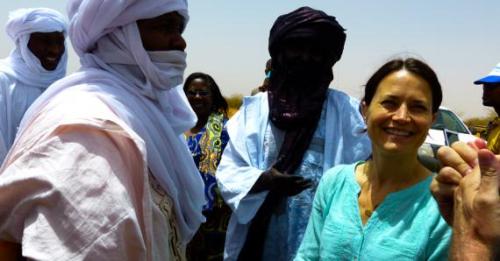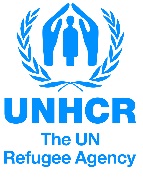A Different Kind of Refugee Settlement
 Deputy Assistant Secretary for Population, Refugees, and Migration Catherine Wiesner visits Intikane, an area hosting refugees in Niger’s Tahoua region, in July 2015.
Deputy Assistant Secretary for Population, Refugees, and Migration Catherine Wiesner visits Intikane, an area hosting refugees in Niger’s Tahoua region, in July 2015.
In 2012, hundreds of thousands of people fled northern Mali to seek safety from an armed rebellion and insurgency that included Islamist militants associated with Al Qaeda. These displaced people, many of whom were received as refugees in neighboring countries, posed unique challenges for groups who wanted to help them. Many northern Malians are nomadic herders who move throughout the year as they seek good grazing land for their livestock. When they fled Mali, they came with not only their families, but also their animals.
In Niger, UNHCR set up refugee camps to provide shelter and emergency assistance to people fleeing the war, but soon learned there were groups of nomadic refugees living along the Mali-Niger border. They weren’t safe there, but were hesitant to move further inland to a refugee camp if they couldn’t bring their herds of cattle and camels.
So the UN and Nigerien government came up with a new plan. They decided to allow pastoral communities to bring their entire herds – thousands of animals, all told – into Niger. The government agreed to grant the refugees access to vast pasture lands, some 600 square kilometers at Intikane alone. The land was good for animals, but was sparsely inhabited because of poor access to water. In exchange, UNHCR agreed to rehabilitate a well that could provide water to the local community and the refugees, as well as to their livestock.
Today, Intikane hosts 14,500 Malian refugees – more than any refugee camp in Niger. Refugees can settle freely and move with their herds, and they and local Nigeriens benefit from the water infrastructure, clinic, and school UNHCR has opened. The Intikane school has grown to become the largest in Tahoua region, and attendance rates among refugee children are higher than they were back in Mali before the conflict.
 Tuareg men and boys came on camel back to greet Deputy Assistant Secretary Wiesner’s caravan during her visit to Intikane [State Department Photo]
Tuareg men and boys came on camel back to greet Deputy Assistant Secretary Wiesner’s caravan during her visit to Intikane [State Department Photo]
We arrived at Intikane just as the first rains of the season were bringing trees back to life. The refugees’ tents were scattered across the valley, not lined up close together. It looked like a typical Malian village, not a refugee camp.
Several dozen Tuareg men and boys came on camel back to greet our caravan. Together with local authorities, refugee leaders showed us the rehabilitated well, and the pumping station that provides drinking water for the refugees, a nearby village, and a watering post where cattle, camels, and donkeys were drinking from low metal troughs. The refugees told me that having water and grazing land for their livestock enabled them to provide for their families, and they described how much they preferred this to living in a camp.
The United States is the single largest donor to refugee programs in Africa, and we fully encourage UNHCR’s efforts to work with governments to establish alternatives to camps. In fact, for many years now, the United States has been working to implement a policy that seeks to develop and strengthen models of refugee assistance outside of camps. We believe there should be more places, like Intikane, that allow refugees to organize their own communities, and live with the greater dignity and independence.
About the Author: Catherine Wiesner serves as Deputy Assistant Secretary of State for Population, Refugees, and Migration.
- See more at: http://blogs.state.gov/stories/2015/07/29/different-kind-refugee-settlement#sthash.n2GQ5e2O.dpuf
Beyond boundaries: How to help nomadic refugees
Nomadic or semi-nomadic populations often struggle when hemmed into refugee camps. They are used to having a lot of space and being mobile, and they typically travel with a lot of animals, which comprise both their assets and livelihoods. Yet camp boundaries are necessary to determine who is receiving assistance and to ensure aid meets humanitarian standards. Read the full article by Irin News by clicking on the title above.
Intikane, area for nomadic refugees in Niger
UNHCR’s team in Tahoua received the 2013 award for Team Achievement in Field Operations for having successfully carried out the relocation of about 8,000 refugees and returnees from the border to the safer hinterland and the grazing lands of Intikane. The video link below describes Intikane and the new concept of a “hosting area / zone d’accueil” developed to adapt to the needs of nomadic and pastoralist refugees, an innovative refugee setting different from the classic refugee camp.
La zone d'accueil est un concept nouveau mis en place par le HCR en lien avec les communautés et autorités locales pour s'adapter au mode de vie des réfugiés nomades. Il se distingue de l'organisation classique d'un camp et permet aux réfugiés nomades de s'installer librement dans une vaste zone de paturage avec leur bétail. La première zone d'accueil a été ouverte à Intekan en avril 2013 avec la relocalisation réussie de près de 8000 réfugiés et l'organisation d'une caravane d'animaux. Une deuxième zone d'accueil a été ouverte à Tazalite, toujours dans la région de Tahoua, en juin 2013.
————————————————————————————-
The “zone d'accueil” (nomadic area) is a new concept developed by UNHCR in conjunction with local authorities and communities to adapt to the lifestyle of nomadic refugees. It differs from the traditional organization of a refugee camp and allows refugees to settle freely in a vast pasture area with their livestock. The first “zone d'accueil” was opened in Intekan in April 2013 with the successful relocation of nearly 8,000 refugees and a convoy or caravan of animals to the area. A second nomadic area was opened in Tazalite, still in the Tahoua region in June 2013.
Source: youtube.com

